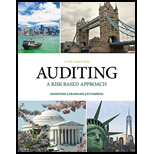
Auditing: A Risk Based-Approach (MindTap Course List)
11th Edition
ISBN: 9781337619455
Author: Karla M Johnstone, Audrey A. Gramling, Larry E. Rittenberg
Publisher: Cengage Learning
expand_more
expand_more
format_list_bulleted
Question
Chapter 5, Problem 43CYBK
To determine
Introduction:Auditor is appointed by the company in order to get their financial statements checked whether they are authentic or reliable for further usage by the shareholders and other users.
To select: The correct option regarding the performance of substantive
Expert Solution & Answer
Want to see the full answer?
Check out a sample textbook solution
Students have asked these similar questions
Franklin & Baker Consulting had a net income of $68,000 and net sales of $425,000. Compute the relationship of net income to net sales.
I am searching for the right answer to this financial accounting question using proper techniques.
What is the variable cost per unit processed?
Chapter 5 Solutions
Auditing: A Risk Based-Approach (MindTap Course List)
Ch. 5 - Prob. 1CYBKCh. 5 - Prob. 2CYBKCh. 5 - Prob. 3CYBKCh. 5 - Prob. 4CYBKCh. 5 - Prob. 5CYBKCh. 5 - Prob. 6CYBKCh. 5 - Prob. 7CYBKCh. 5 - Prob. 8CYBKCh. 5 - Prob. 9CYBKCh. 5 - Prob. 10CYBK
Ch. 5 - Prob. 11CYBKCh. 5 - Prob. 12CYBKCh. 5 - Prob. 13CYBKCh. 5 - Prob. 14CYBKCh. 5 - Prob. 15CYBKCh. 5 - Which of the following accounts would not be...Ch. 5 - Prob. 17CYBKCh. 5 - Prob. 18CYBKCh. 5 - Prob. 19CYBKCh. 5 - Which management assertion is usually most...Ch. 5 - Prob. 21CYBKCh. 5 - Prob. 22CYBKCh. 5 - Prob. 23CYBKCh. 5 - Prob. 24CYBKCh. 5 - Prob. 25CYBKCh. 5 - Prob. 26CYBKCh. 5 - Prob. 27CYBKCh. 5 - Prob. 28CYBKCh. 5 - Prob. 29CYBKCh. 5 - Prob. 30CYBKCh. 5 - Prob. 31CYBKCh. 5 - Prob. 32CYBKCh. 5 - Prob. 33CYBKCh. 5 - Prob. 34CYBKCh. 5 - Prob. 35CYBKCh. 5 - Prob. 36CYBKCh. 5 - Prob. 37CYBKCh. 5 - Prob. 38CYBKCh. 5 - Prob. 39CYBKCh. 5 - Prob. 40CYBKCh. 5 - Prob. 41CYBKCh. 5 - Prob. 42CYBKCh. 5 - Prob. 43CYBKCh. 5 - Prob. 44CYBKCh. 5 - Prob. 45CYBKCh. 5 - Prob. 46CYBKCh. 5 - Prob. 47CYBKCh. 5 - Prob. 48CYBKCh. 5 - Prob. 1RQSCCh. 5 - Prob. 2RQSCCh. 5 - Prob. 3RQSCCh. 5 - Prob. 4RQSCCh. 5 - Prob. 5RQSCCh. 5 - Prob. 6RQSCCh. 5 - Professional guidance indicates that the auditor...Ch. 5 - Identify the accounts associated with the...Ch. 5 - Assume that an organization asserts that it has...Ch. 5 - Prob. 10RQSCCh. 5 - Prob. 11RQSCCh. 5 - Prob. 12RQSCCh. 5 - Prob. 13RQSCCh. 5 - List factors that might affect an audit firm’s...Ch. 5 - Prob. 15RQSCCh. 5 - Prob. 16RQSCCh. 5 - Prob. 17RQSCCh. 5 - Prob. 18RQSCCh. 5 - Prob. 19RQSCCh. 5 - Prob. 20RQSCCh. 5 - Prob. 21RQSCCh. 5 - Prob. 22RQSCCh. 5 - Prob. 23RQSCCh. 5 - Prob. 24RQSCCh. 5 - Prob. 25RQSCCh. 5 - Prob. 26RQSCCh. 5 - Prob. 27RQSCCh. 5 - Prob. 28RQSCCh. 5 - Prob. 29RQSCCh. 5 - Prob. 30RQSCCh. 5 - Prob. 32RQSCCh. 5 - Prob. 33RQSCCh. 5 - Prob. 34RQSCCh. 5 - Prob. 35RQSCCh. 5 - Prob. 36RQSCCh. 5 - Prob. 37RQSCCh. 5 - Prob. 38RQSCCh. 5 - Prob. 39RQSCCh. 5 - Prob. 40RQSCCh. 5 - Prob. 42RQSCCh. 5 - Prob. 43RQSCCh. 5 - Prob. 44FF
Knowledge Booster
Similar questions
- Please provide the accurate answer to this general accounting problem using valid techniques.arrow_forwardPlease provide the correct answer to this general accounting problem using accurate calculations.arrow_forwardMontu Consultants Corporation obtained a building, its surrounding land, and a computer system in a lump-sum purchase for $375,000. An appraisal set the value of the land at $184,500, the building at $144,000, and the computer system at $121,500. At what amount should Montu Consultants record each new asset on its books?arrow_forward
- Please provide the correct answer to this general accounting problem using accurate calculations.arrow_forwardI am trying to find the accurate solution to this financial accounting problem with the correct explanation.arrow_forwardCan you solve this general accounting question with accurate accounting calculations?arrow_forward
- I am searching for the correct answer to this financial accounting problem with proper accounting rules.arrow_forwardCan you solve this general accounting problem using appropriate accounting principles?arrow_forwardI am searching for a clear explanation of this financial accounting problem with valid methods.arrow_forward
- I need help with this general accounting question using the proper accounting approach.arrow_forwardDonna Steakhouse, a high-end restaurant, began its operations in 2018. Its fixed assets had a book value of $1,250,000 in 2019. The restaurant did not purchase any fixed assets in 2019. The annual depreciation expense on fixed assets was $125,000, and the accumulated depreciation account had a balance of $250,000 on December 31, 2019. What was the original cost of fixed assets owned by the restaurant in 2018 when it started its operations?arrow_forwardI need help with this general accounting question using standard accounting techniques.arrow_forward
arrow_back_ios
SEE MORE QUESTIONS
arrow_forward_ios
Recommended textbooks for you
 Auditing: A Risk Based-Approach (MindTap Course L...AccountingISBN:9781337619455Author:Karla M Johnstone, Audrey A. Gramling, Larry E. RittenbergPublisher:Cengage Learning
Auditing: A Risk Based-Approach (MindTap Course L...AccountingISBN:9781337619455Author:Karla M Johnstone, Audrey A. Gramling, Larry E. RittenbergPublisher:Cengage Learning Auditing: A Risk Based-Approach to Conducting a Q...AccountingISBN:9781305080577Author:Karla M Johnstone, Audrey A. Gramling, Larry E. RittenbergPublisher:South-Western College Pub
Auditing: A Risk Based-Approach to Conducting a Q...AccountingISBN:9781305080577Author:Karla M Johnstone, Audrey A. Gramling, Larry E. RittenbergPublisher:South-Western College Pub

Auditing: A Risk Based-Approach (MindTap Course L...
Accounting
ISBN:9781337619455
Author:Karla M Johnstone, Audrey A. Gramling, Larry E. Rittenberg
Publisher:Cengage Learning

Auditing: A Risk Based-Approach to Conducting a Q...
Accounting
ISBN:9781305080577
Author:Karla M Johnstone, Audrey A. Gramling, Larry E. Rittenberg
Publisher:South-Western College Pub
